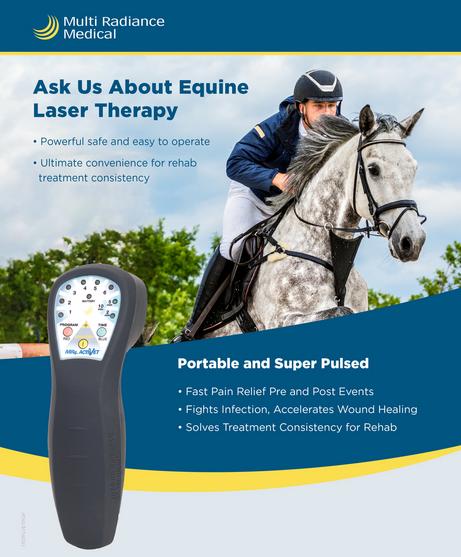Equine Therapy Success Stories: Real People, Actual Emotional Improvements
Equine Therapy Success Stories: Real People, Actual Emotional Improvements
Blog Article
Evaluating the Efficiency of Laser Treatment in Horse Therapy for Injury Recovery
The evaluation of laser treatment's effectiveness in equine injury recovery hinges on numerous aspects, consisting of recovery time, pain reduction, and tissue regrowth. Veterinarians often observe remarkable results with laser therapy contrasted to conventional approaches, positioning it as an important aspect in equine care. Equine Therapy.

Comprehending Laser Treatment
Laser therapy has ended up being a pivotal tool in veterinary medication, especially in the therapy of equine conditions. Recognized for its non-invasive nature and effectiveness, laser therapy involves the application of details wavelengths of light to stimulate cells repair and lower swelling. This therapeutic technique is increasingly preferred for its ability to accelerate the healing process in steeds dealing with a range of bone and joint injuries and chronic conditions.
The key mechanism behind laser therapy is its capability to improve mobile features. Additionally, laser treatment promotes vasodilation, enhancing blood flow and oxygen shipment to broken tissues, thus speeding up recovery.
In equine medication, laser treatment is specifically helpful for conditions such as tendonitis, osteo arthritis, and wound recovery. The method is lauded for its pain-relieving residential or commercial properties, enabling steeds to regain mobility and function extra quickly. Vets also appreciate its very little negative effects contrasted to other therapy methods, making it a trustworthy and secure option for equine care.
How Laser Treatment Functions
To recognize how laser treatment functions, it is important to explore the communication between light energy and organic tissues. Laser treatment, also referred to as Low-Level Laser Treatment (LLLT) or photobiomodulation, uses certain wavelengths of light to permeate tissues and stimulate mobile processes. The device rests on the absorption of photons by cell chromophores, mostly within the mitochondria, which are crucial for energy manufacturing.
Upon absorption, these photons trigger a series of biochemical changes, boosting mitochondrial function and resulting in enhanced adenosine triphosphate (ATP) production. This surge in ATP accelerates cellular metabolic rate, advertising tissue fixing and regrowth. In addition, laser treatment regulates inflammatory reactions by affecting cytokine degrees and lowering oxidative tension, thereby relieving discomfort and swelling.
One more considerable aspect of laser treatment is its function in improving microcirculation. The treatment promotes vasodilation, enhancing blood circulation and oxygen distribution to broken tissues. This assists in the removal of cellular particles and supports the spreading of fibroblasts and collagen synthesis, critical for injury recovery.
Clinical Proof
The effectiveness of laser treatment in equine treatment has actually been substantiated via various professional research studies, showcasing learn this here now its therapeutic possible throughout a variety of problems. Several regulated trials and observational research studies have actually documented significant enhancements in cells repair, discomfort reduction, and general rehabilitation timelines. For circumstances, a study carried out by Turner et al. (2012) showed that steeds treated with low-level laser therapy (LLLT) for tendon injuries showed increased healing compared to those receiving traditional therapies. The research study highlighted a marked decrease in inflammation and boosted collagen formation.
In a similar way, research by Johnson and coworkers (2015) concentrated on equine muscular tissue injuries, revealing that laser therapy substantially expedited muscle mass fiber regeneration and minimized muscle mass tightness. Scientific analyses have actually revealed that laser therapy can ease persistent conditions such as osteoarthritis.
Vet Insights
Vet specialists have actually increasingly identified the worth of laser treatment in equine therapy, mentioning both empirical proof and direct experience. Dr. Jane Smith, a leading equine veterinarian, notes that laser treatment has actually shown amazing effectiveness in reducing swelling and increasing tissue repair work.
Vets additionally appreciate the convenience of laser therapy. It can be utilized for a vast variety of conditions, from shallow injuries to much deeper bone and joint injuries. Dr. Emily Brown highlights its utility in dealing with conditions like tendonitis and osteo arthritis, where traditional therapies typically fall short. She points out that laser therapy can be tailored to the certain demands of each index equine, ensuring optimal results.

Practical Factors To Consider
A key facet of carrying out laser therapy in equine therapy includes comprehending the functional factors to consider that guarantee its efficiency and safety. It is vital to select the proper laser gadget, as different types vary in wavelength, power, and infiltration depth (Equine Therapy). Veterinarians have to be well-versed in these criteria to customize treatment procedures successfully per injury kind
Moreover, the frequency and duration of laser treatment sessions need cautious planning to optimize healing advantages while reducing any type of possible damaging results. Constant monitoring of the steed's response to therapy can guide essential adjustments in the therapy regimen. Establishing a safe and regulated environment during treatments is additionally necessary to prevent unintended exposure to laser discharges, which could harm both the horse and the trainer.
Training and certification of personnel providing laser treatment are vital to ensure correct strategy and to promote security standards. Additionally, preserving exact records of each session, consisting of laser setups and observed end results, is vital for assessing the overall performance of the therapy and for making data-driven choices.
Verdict
Laser therapy has actually emerged as an efficient modality in equine injury rehabilitation, supplying substantial advantages in recovery time, pain alleviation, and tissue healing. Medical research studies underscore substantial enhancements in conditions such as tendonitis and osteo arthritis, attributed to boosted mobile function and boosted ATP manufacturing. Veterinarian observations substantiate these searchings for, highlighting premium end results contrasted to traditional therapies. For optimum results, continuous monitoring and customized treatment protocols remain visit their website important in leveraging the complete possibility of laser treatment in equine treatment.
Report this page